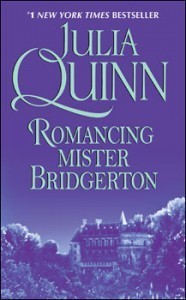Alison Atlee's Blog, page 2
August 5, 2013
Today’s Unforgettable Adventure: The Typewriter Girl by Alison Atlee
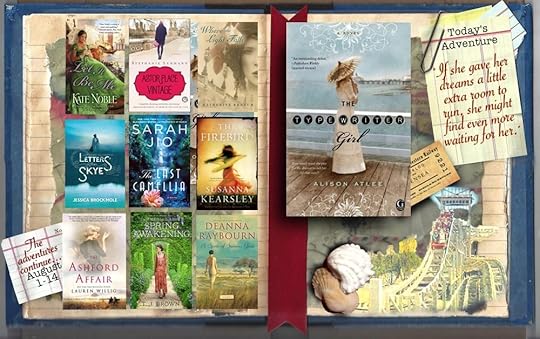
Unforgettable Adventure 4: The Typewriter Girl by Alison Atlee
10 Great Authors, 10 Unforgettable Adventures. It’s Betsey the typewriter girl’s turn in the giveaway, and there are two ways to enter to win The Typewriter Girl and the grand prize of all ten book: Subscribe and confirm to my blog (see the sidebar to the right), or like my Facebook page. Enter at both places to double your winning chances; check out all the authors’ links below for even more ways to enter.
A little about Betsey’s adventure:
“But did you know it is almost the best job in London a girl could hope for?”
That question of Betsey Dobson’s turned up in the earliest draft of The Typewriter Girl and survived many revisions, but it took awhile for me to understand just how much it expressed about Betsey and the adventure that changes her life.
Funny how we speak of adventure: Adventure awaits. It beckons, calls. We discover adventure, we embark upon it.
Which all suggests that we have to make ourselves available to it. A shiny new adventure might be sitting in the driveway with a full tank of gas, but it’s going nowhere until we take our place in the driver’s seat.
What I loved about writing Betsey’s adventure was how she kept letting it grow, just a little at a time. She thinks she’s made it, there at the beginning of the story. Getting that typewriting job was an enormous accomplishment for her. She thinks, If I can just hold on to this much, I won’t ask for more.
Except for the word “almost.” Almost the best job. To me, that signaled a spark inside Betsey, a belief that if she gave her dreams a little extra room to run, they’d grow. And then, anything was possible.
Remember, there are two ways to enter the giveaway: Like my Facebook page and/or use form in the sidebar to subscribe and confirm to the blog. Do both and get two chances to win.
Keep up with the latest adventures and chances to win through any of the authors:
Jessica Brockmole , Letters from Skye Facebook
T.J. Brown , Summerset Abbey: Spring Awakening Facebook
Sarah Jio , The Last Camellia Facebook
Susanna Kearsley , The Firebird Facebook
Katherine Keenum , Where the Light Falls
Stephanie Lehmann , Astor Place Vintage Facebook
Kate Noble , Let It Be Me Facebook
Deanna Raybourn , A Spear of Summer Grass Facebook
Lauren Willig , The Ashford Affair Facebook

Today’s Unforgettable Adventure: Summerset Abbey: Spring Awakening, by T.J. Brown
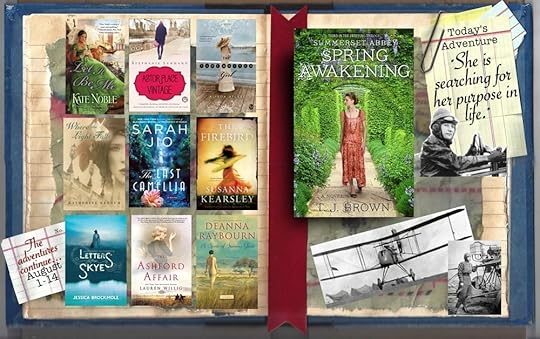
Unforgettable Adventure #3: SUMMERSET ABBEY: SPRING AWAKENING, by T.J. Brown
The 10 Great Authors, 10 Unforgettable Adventures giveaway continues today with T.J. Brown. With every post between August 1 and August 13, you can register to win this book and the grand prize of all 10 books. We’ll announce winners on August 14. You may enter today’s giveaway and the grand prize at T.J.’s blog, http://teribrownbooks.com/tjblog/ . You’ll find links to all the authors below–follow any of them to keep up with the latest adventures.
And now, T.J. on WWI Women and Their Flying Machines:
Come Josephine in my flying machine
Going up she goes! Up she goes!
Balance yourself like a bird on a beam
In the air she goes! There she goes!
Up, up, a little bit higher
Oh! My! The moon is on fire
Come Josephine in my flying machine
Going up, all on, Goodbye!
Aeroplanes play a big part in the Summerset Abbey trilogy and the eldest sister, Rowena, becomes a volunteer pilot in World War One. Did I stretch the truth too far or did I not go far enough? Through my research I found that while the numbers were small, there were women who flew actual combat and reconnaissance missions during the war and many more who worked in aeroplane production. The following women were pilots during the war when aircraft technology was in its earliest stages:
Helene Dutrieu flew reconnaissance flights from Paris to check on German troop movements.
Marie Marvingt flew bombing missions over Germany and was probably the first women to fly actual combat missions.
Russia had several such daring aviatrixes: Princess Eugenie M. Shakovskaya, Helen P. Samsonova, Princess Sophie A. Dolgorukaya and Nadeshda Degtereva all flew during the war, though in different capacities.
It’s important to remember just what a fledging science aircraft actually was. For the first two years of WWI, the average life expectancy for pilots was 10–15 days to three weeks due to the rushed training and the rapid increase of the quality of German planes.
In Summerset Abbey: Spring Awakening, Rowena volunteers to transport newly built aeroplanes, as well as flying key officials, to various military bases. When the series begins, Rowena is diffident and a bit lost. She is searching for her purpose in life. When she takes to the air for the first time as a passenger, she knows immediately that she has found it. Flying becomes her passion and she does most of her growing as a character while in the air. Volunteering for the war effort gives her adventurous spirit an outlet and changes her outlook on life.
Don’t forget to enter at T.J.’s blog, http://teribrownbooks.com/tjblog/ . Keep up with the latest adventures and chances to win through any of the authors:
Alison Atlee , The Typewriter Girl Facebook
Jessica Brockmole , Letters from Skye Facebook
T.J. Brown , Summerset Abbey: Spring Awakening Facebook
Sarah Jio , The Last Camellia Facebook
Susanna Kearsley , The Firebird Facebook
Katherine Keenum , Where the Light Falls
Stephanie Lehmann , Astor Place Vintage Facebook
Kate Noble , Let It Be Me Facebook
Deanna Raybourn , A Spear of Summer Grass Facebook
Lauren Willig , The Ashford Affair Facebook

August 2, 2013
Today’s Unforgettable Adventure: THE ASHFORD AFFAIR, by Lauren Willig
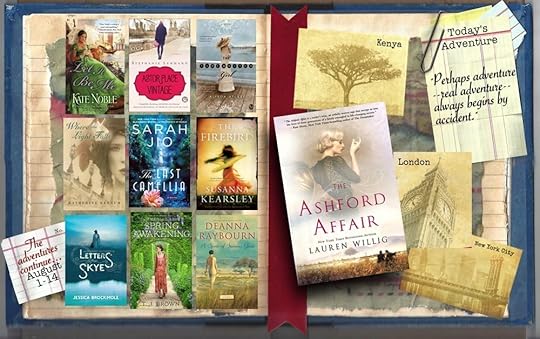
Unforgettable Adventure 2; THE ASHFORD AFFAIR by Lauren Willig
10 Great Authors, 10 Unforgettable Adventures. With every “Today’s Adventure” post between August 1 and August 13, you can register to win the featured book and the grand prize of all 10 books. We’ll announce winners on August 14. You may enter today’s contest at Lauren’s website, http://www.laurenwillig.com/news/contest.php , OR by liking her Facebook page, https://www.facebook.com/LaurenWillig . Find links to all the authors below–follow any of them to keep up with the latest adventures.
Here’s Lauren:
“They really lived, didn’t they?” says my modern heroine wistfully.
It’s 1999, and my modern heroine, Clemmie Evans, is looking around her own life—endless work at a law firm where she’s hoping to make partner, a studio apartment she’s never properly moved into—and realizing that she doesn’t entirely like what she sees. As she starts to dig into the life of her grandmother, she feels shamed by the dramatic changes her grandmother encountered and mastered: the twilight of the aristocracy, two World Wars, a move from London to Kenya and then from Kenya to New York.
Of course, Clemmie doesn’t know the whole story. As the book opens, we meet her grandmother Addie in 1926, on a train from Mombasa to Nairobi, stained with sweat and dust, wondering what on earth she’s doing, leaving her flat, job, and fiancé back in London to travel halfway across the world to visit a cousin she hasn’t seen in five years, a cousin who was once her closest friend and then the source of her greatest tragedy.
Both women, one in 1926, one in 1999, are about to embark on journeys that will change their lives, journeys both physical and emotional.
Perhaps adventure—real adventure—always begins by accident….
To learn more about THE ASHFORD AFFAIR, visit my website at http://www.laurenwillig.com/books/ashford.php, where you can find the Prologue and first chapter of the book.
There are two ways to win a signed copy of THE ASHFORD AFFAIR! You can pop by the Contest page on my website ( http://www.laurenwillig.com/news/contest.php ) and enter there OR like my Facebook page, https://www.facebook.com/LaurenWillig . I’ll be picking one winner from each.
Keep up with the latest adventures and chances to win through any of the authors:
Alison Atlee , The Typewriter Girl Facebook
Jessica Brockmole , Letters from Skye Facebook
T.J. Brown , Summerset Abbey: Spring Awakening Facebook
Sarah Jio , The Last Camellia Facebook
Susanna Kearsley , The Firebird Facebook
Katherine Keenum , Where the Light Falls
Stephanie Lehmann , Astor Place Vintage Facebook
Kate Noble , Let It Be Me Facebook
Deanna Raybourn , A Spear of Summer Grass Facebook
Lauren Willig , The Ashford Affair Facebook

August 1, 2013
Today’s Unforgettable Adventure: Let It Be Me, by Kate Noble

Unforgettable Adventure Giveaway: Let It Be Me by Kate Noble
It starts today! 10 Great Authors, 10 Unforgettable Adventures. With every “Today’s Adventure” post between August 1 and August 13, you can register to win the featured book and the grand prize of all 10 books. We’ll announce winners on August 14. You may enter today’s contest by going tO Kate’s Facebook page and liking it. Find links to all the authors below–follow any of them to keep up with the latest adventures.
Here’s Kate:
Everyone needs the chance to be new, at one time or other. The chance to experience different sights and sounds, the ability to be open to learning new things and new ways of being. To let go of a (slightly) disastrous past andface the world with a fresh perspective.
That’s how Bridget Forrester feels, in Let It Be Me, when she takes advantage of a tree falling on her house to persuade her family to go to Venice for the season. She needs a fresh start – last season was abysmal, living in her sister’s shadow. In Venice, she can be someone different, someone mysterious – and she’s been invited to study piano with the renowned composer Vincenzo Carpenini. It will be the grandest adventure of Bridget’s life.
The only problem is, when she arrives, Carpenini has never heard of her. But his friend, theater-owner Oliver Merrick has. He’s been writing letters on Carpenini’s behalf, and the minute he sees Bridget’s green, trusting eyes, he knows he’s only invited trouble to Venice.
But when Carpenini and Oliver get Bridget involved in a wager, she is thrust into the glittering and dangerous world of Venice’s musical elite, and she must work harder than she has ever worked in her life. She must transform herself from an amateur into a master pianist. But as difficult as it is, with Oliver at her side, it is something magical.
It becomes the grandest adventure of Bridget’s life.
Ready to join Bridget in Venice? Remember to like Kate Noble’s Facebook page, and you’ll be entered to win Let It Be Me and the other nine stories. Keep up with the latest adventures and get more chances to win through any of the authors:
Alison Atlee, The Typewriter Girl (Facebook)
Jessica Brockmole, Letters from Skye (Facebook)
T.J. Brown, Summerset Abbey: Spring Awakening (Facebook)
Sarah Jio, The Last Camellia (Facebook)
Susanna Kearsley, The Firebird (Facebook)
Katherine Keenum, Where the Light Falls
Stephanie Lehmann, Astor Place Vintage (Facebook)
Kate Noble, Let It Be Me (Facebook)
Deanna Raybourn, A Spear of Summer Grass (Facebook)
Lauren Willig, The Ashford Affair (Facebook)

July 28, 2013
Giveaway: 10 Great Authors, 10 Unforgettable Adventures
This giveaway starts August 1st, so if you’re here early, be sure to come back. We’ve got some fabulous reads to share with you, some from best-selling authors you already know, and some we hope will be new favorites for you. I’ll post updates here on the blog from August 1 to August 14, so if you’ve found this post, you’re in the right place. In the meantime, check out these gorgeous covers to see what’s up for grabs:

Mrs. Hughes’ Scandalous Toaster and the Unexpected Controversy of Other Commonplace Things
Maggie Smith’s scene-terminating quips aside, the most delightful moments of a Downton Abbey episode occur when a character squints, bewildered and curious, at some mundane object or concept: Carson the butler ranks an electric toaster alongside the ordeal of “sheltering a dangerous revolutionary.” The Dowager Countess wonders, “What is a weekend?”
And suddenly, a fourteen-dollar kitchen appliance and two alarm clock-free days become exotic to us, too. New Yorker blogger Alexandra Lange notes that when it comes to technology on Downton Abbey, it’s the female characters who are the “chief users and beneficiaries” of it.
Women doing almost anything beyond the spheres of marriage and motherhood provoked controversy throughout the Victorian and Edwardian eras. Add in new technology or a social innovation, and the shock factor multiplied. Consider these four novelties from the 19th century:
The Bicycle: Imagine pedaling a bicycle side-saddled. The author of an 1869 cycling guide does, describing a bicycle (or velocipede, as it was often called then) adapted to be suitable for ladies to operate.
He seems baffled as to why a lady would want to operate a bicycle when she could very pleasantly be a passenger on her husband’s, but as women seem determined to do so, he thus explains the required equipment and clothing. He concludes with a plea: don’t go riding in all-female groups. “Custom and nature revolt against it,” and it isn’t feminine.
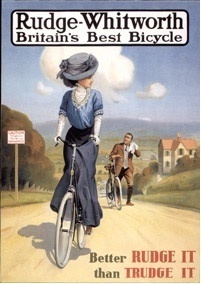
A woman traveling independently? She must be up to something.
For obvious reasons, side-operated bicycles never really caught on, but cycling for both men and women boomed later in the century. However, a woman on a bicycle remained a target of criticism. The Women’s Rescue League (picture Downton’s Isobel Crawley as a charter member) called cycling “the devil’s advance agent, morally and physically, in thousands of cases.” Besides being vulgar, cycling endangered ladies’ health and promoted casual socialization between the sexes. Worse, it gave women the means to travel independently. And if they wished to do that, just what were they up to?
Defenders of the bicycle admitted that possibly, the occasional “impure” woman had indeed cycled her way to the site of some immoral deed, but they roundly denounced any connection between cycling and Satan.
Croquet: This game probably puts you more in mind of linen suits and tea parties than Nike shoes and Gatorade, but did you know it was once (and only once, in 1900) an Olympic sport? The controversy of croquet was rooted in its popularity: in the 1860’s it was growing so rapidly that no one could agree on the rules. Croquet enthusiasts of the time lament the fact that players from different towns could hardly get through a game without heated arguments over the right way to play it.
[image error]
No Title IX in 1906, but there was croquet.
But more importantly, croquet became popular at a time when Victorian society was considering the possibility that a bit of exercise for women might not mark the downfall of Western society after all. Couldn’t have them sweating, of course, but a game like croquet, even though it posed the risk of an exposed ankle here and there, was deemed appropriate for women.
Croquet gave us the earliest sports clubs that included women, as well as, according to Olympic Games historian Bill Mellon, the first female Olympians–competing alongside the men, no less. So if you’re a woman who’s ever taken it for granted that you could compete on a sports team or hit the gym after work, take a moment to thank croquet.
The Dishwasher: Josephine Cochrane invented the dishwasher because, it is said, she was tired of the servants breaking her expensive china. However, the fact she devoted the rest of her life to perfecting and promoting the machine suggests much more about her drive and intelligence than her concern for broken dishes.
At any rate, the only initial protests against the dishwasher came from workers displaced by the machine. Hotels and restaurants eagerly installed dishwashers, and Cochrane’s invention won a top award at the 1893 World’s Fair in Chicago.
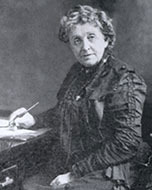
Josephine Cochrane: More than just a desperate housewife.
It wasn’t until Cochrane tried to convince consumers they needed a family-sized version of the machine that she ran into real resistance. While some questioned the morality of taking women from their God-given duties as homemakers, the main issue was that women didn’t want it. It required more hot water than most households could generate, for one thing.
For another, it turned out that in the wide spectrum of housekeeping chores, washing dishes fell in the “somewhat pleasant” end. It would take decades and post-WWII consumerism to make the dishwasher a standard kitchen feature.
The Typewriter: It brought the usual bustle of Downton Abbey’s downstairs to a halt in Season One as the staff gathered round to gawk at Gwen the maid’s secret typewriter. In reality, the typewriter was no longer such a novelty in 1912. Though some worried the machine would depersonalize social correspondence (rather like some wonder today whether Facebook undermines our “real life” relationships), typewriters were just too simple and practical not to be quickly adopted.
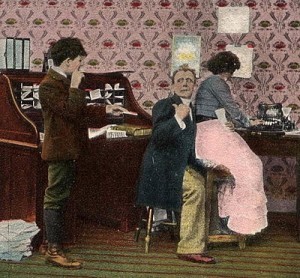
Office mayhem: It’s the typewriter girl’s fault.
The real controversy of the typewriter wasn’t the machine, but its effect. Historian Anna Davin compared the typewriter to the Trojan horse, bringing an army of female clerical workers into a city of men. By the time Gwen the maid is trying to break in, the number of female clerical workers has surged by almost 2000% over the space of a few decades.
In The Twelve Pound Look, a 1910 play by Peter Pan author J.M. Barrie, the price of a typewriter (£12) allows a woman to leave an unhappy marriage and support herself, as sensational a premise as Thelma and Louise was in its day. Some rejoiced in the earning opportunities this new technology offered women. Others were doubtful or just plain scandalized: Do women have the physical stamina to keep working hours? Won’t they be morally corrupted? Aren’t they taking jobs from the men they should be marrying?
The one sure thing: the typewriter made a new world of the workplace.

May 30, 2013
Writers Who Meet Readers
And I don’t really know Pam, either, but in a funny way, I feel I know something about her heart. At the booksigning at the RT Booklover’s Convention, I found myself seated near the amazing and legendary Mary Balogh, whose books I have loved and even studied. I came into the signing with plenty of hopes and goals–meet readers! Hand out magnets and postcards! Sell books! But when I saw Mary Balogh’s name card on the table to my left, something told me to slow down and savor what being here at this signing meant.
I’m so glad I did, because otherwise I might have missed Pam. She was in Mary’s line (Mary Balogh had a l-i-i-i-i-i-ne, you see. Me, not so much!), and in one of my take-a-deep-breath-and-be-here-now moments, I saw her say a few words to Mary and give her a present, a handkerchief embroidered with Proverbs 3:5–6 (“Trust in the Lord with all thine heart, and lean not unto thine own understanding. In all thy ways acknowledge him, and he shall direct your paths.”):
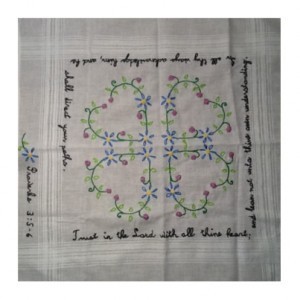
I got teary, seeing the beautiful craftsmanship of the embroidery and the heartfelt spirit in which Pam offered that gift. I knew her in that moment, trying to express to an author what her books have meant to you, wanting to give back some part of the joy and meaning the stories gave to you.
Pam and I chatted for a few minutes afterwards, and she moved on. Mary Balogh’s huge stack of books disappeared quickly, but she graciously remained at her table to sign bookmarks (which are wonderfully British, as you can see here). My little stack of books got smaller in a more gradual way, and I was feeling braver about talking to “strangers”–not my natural bent, but everyone was so excited and kind, it felt that way. Then, at one point, I glanced up, and saw Pam again.
She’d brought me a handkerchief. She had gone all the way to her car and back to bring me a lovingly-crafted gift and to wish me well with my writing.
My first reaction was to refuse. Because, you know, I don’t deserve this gift. I haven’t earned Pam’s regard the way Mary Balogh has; I can’t think that I ever will. But Pam wanted me to have it, and so I took home this reminder of grace and of trust, and of the reason to write from my heart.
I was so overwhelmed I forgot to get Pam’s contact information so I could thank her properly. I hope our paths cross again sometime. For now, I’ll have to say thank you from here. I will treasure it always, Pam, not just for its beauty, but because it took only a second or two in your presence to know the loving spirit behind its creation.
Writers who meet readers–we’re not just lucky. We are blessed.

April 1, 2013
In honor of Julia Quinn: The Bridgerton Ode
Out today: A new Bridgerton epilogue by Julia Quinn (The Bridgertons: Happily Ever After), and in observance, I’m sharing a poem I wrote about the series. Yeah, that’s right. Serious fangirl stuff, writing a poem. When He Was Wicked was one of the first romances-from-the-actual-romance-section that I read. I didn’t know many authors in the genre then, and often chose randomly, not even reading the back cover blurb. I do remember reading the dedication in WHWW (something like, “For Paul, even though he thought it should be called Love in the Time of Malaria.”)–it made me laugh, it made me buy the book.
Several people have told me When He Was Wicked is their least favorite of the series, but I loved it. It both charmed and moved me, and the snippets of letters at the beginning of each chapter were a novelty that worked for me. Starting in the middle of the series, I was intrigued by the structure of the concurrent story lines and wanted to know more. I rarely “glom” an author, but I did with all the previous Bridgerton books, plus Quinn’s early novels.
That, plus the alphabetical nomenclature of the Bridgerton clan, plus a familiarity with Edward Gorey’s Gashlycrumb Tinies are all responsible for the following:
THE BRIDGERTON ODE
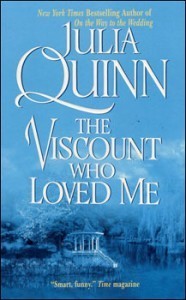 A is for Anthony, chief of the Bridgerton clan,
A is for Anthony, chief of the Bridgerton clan,
reputed a rake, but really, a most prudent and rational man—
unless he’s behind in croquet, and then he turns mad—
Or maybe that’s Kate’s fault; she makes him feel a green lad,
out of his element and off from his norm.
Never mind: together, they weather the storm.
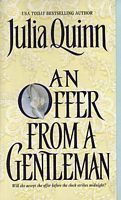 B is for Benedict, the artist, and Sophie’s Prince Charming,
B is for Benedict, the artist, and Sophie’s Prince Charming,
though the offer he makes she finds quite alarming.
His mistress? He doesn’t get it just isn’t enough,
not until he unmasks her Blind Man’s Bluff.
No pumpkins nor palaces needed for this fairy tale,
just My Cottage in the country (and a brief stint in jail).
C is for Colin, green-eyed writer and rover,
Penelope’s first crush she never got over.
Someone should have warned him—blown a whistle, perhaps—
that he’d fall for the quiet girl missed by other chaps.
The pudgy girl next door, in the citrus-colored gown?
The one he swore not to marry? Quite a scoop for Whistledown!
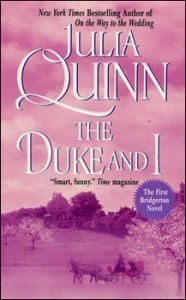 D is for Daphne, who is quick to discover
D is for Daphne, who is quick to discover
even a sham courtship’s tough with a lurking big brother.
A self-controlled Duke it might drive to the edge,
or off to the dueling field after a tryst in the hedge.
Let the men stammer and posture and bait,
then send in the Bridgerton girl to set them all straight.
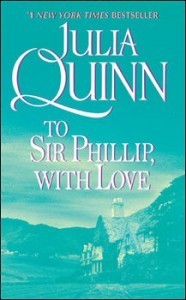 E is for Eloise, and it’s words she lives by,
E is for Eloise, and it’s words she lives by,
either written or spoken, which (let’s face it) can be rough on a guy.
Plants are so quiet—maybe that’s why Phillip loves botany—
but when the time comes to say “I love you”—well, oughtn’t he?
Hiding out in the greenhouse won’t make it all better;
the girl and her brothers will make sure you court to the letter.
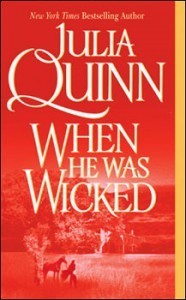 F’s for Francesca, who keeps her wicked side hidden
F’s for Francesca, who keeps her wicked side hidden
from all except Michael, who thinks her forbidden.
Just back from India, the rake’s not feeling that merry:
Malaria’s bad, but then there’s this other fever to carry.
Frannie’s susceptible, too, far more than she thought,
but who can resist a man who keeps your tea water hot?
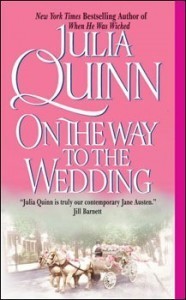 G is for Gregory, who believes this of true love:
G is for Gregory, who believes this of true love:
If it doesn’t take at first sight, you should give it a shove.
Lucy is mystified: Must love befuddle, bemuse?
Why can’t it be orderly, like a neat line of shoes?
But love demands risk, often again and again;
it gives aim to the aimless, summons the rebel within.
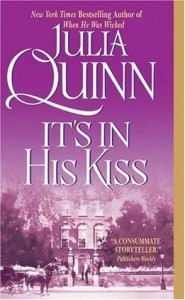 H is for Hyacinth, who’s prone to be blunt,
H is for Hyacinth, who’s prone to be blunt,
ever taking the lead, in waltz or treasure hunt.
You just have to love her—that, or strangulation;
Gareth chooses the former and is soon lost in translation.
If love’s like a musicale, no surprise some notes go amiss,
but hope of family and comfort is what’s in her kiss.
And Q—that’s for Quinn, if a few letters we skip
to honor our author, the Queen of the Quip,
and say thanks—
for siblings quibbling (you do it the best)—
for heroines quirky—
for heroes a-quest—
for quite the quintessence of romance—
each quiver and thrill,
and to risk sounding querulous…
Ms. Quinn, please—
back to your quill.
Okay, it’s no tattooed quote, but it is some form of devotion! Gregory’s stanza is my favorite, I think. Come to Facebook if you want to find out what happened when I sent the poem to Julia Quinn. And I might just put it up on Pinterest, too, but give me a couple of days. Thanks for reading!

June 25, 2012
Betsey’s Collage

As an Argh Ink reader, I’d admired the book collages Jennifer Crusie posted there, but resisted doing one myself. After all, I’d had a rather stressful experience at one of those scrapbook home sales parties. At the end of the evening, everyone else had orders placed and cute layouts all done, while I had an archipelago of loose photos and scrap paper strewn across the host’s coffee table because I couldn’t give myself permission to take shortcuts with pre-made templates.
Thus, a book collage seemed like something that would cost me writing time rather than make me more productive. But then I ended up in one of Jenny’s collage workshops, and that’s where the collage you see here happened.
Sort of. What I made at first was so rough that I almost didn’t bother to lug it home. I made it mainly in the community spirit of the workshop, and with a reminder to myself that with the time and tools available, I wouldn’t be able to make it “perfect.” In other words, I gave myself permission to have fun and make something ugly. In other-other words, my inner critic was not invited.
I rebuilt the collage as I was rebuilding the story in a revision. I remember thinking at one point, “This doesn’t have everything from the book yet, but it feels done.” Hm. I quit working on it.
That turned out to be what I like about this collage: the heart of the story is in it. After a substantial rewrite for my agent, I looked back at it and realized that for all the axing and adding, rearranging and recasting, every single thing represented in the collage was still in the story.
Two common questions I get about it: What does “GOOD BETSEY” mean? and Did the cover artist use it?
1) That’s my name for THE TYPEWRITER GIRL. And yes, I knew what a bad title it was the moment it appeared. Still, when someone tells you her name, you don’t say, “Are you sure?” You just say, “Nice to meet you, Good Betsey.”
2) I have no idea. I don’t think so. I sent the collage along in a batch of other pictures, but there’s nothing to suggest it inspired the cover artist in any particular way. And The Typewriter Girl‘s cover is so lovely, I don’t think the artist needed any help from me.
Oh, have you seen the cover? It really is awfully lovely, isn’t it? Here, have another look:
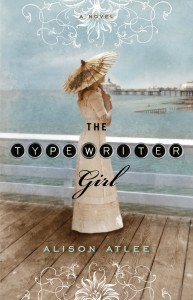
Thanks for dropping by.
Links for this post:
Argh Ink: Jennifer Crusie’s blog
A moment of squee: what Jenny said about Betsey’s collage
Storywonk podcast: authors Lani Diane Rich (Lucy March) and Alastair Stephens discuss collage for writers.

September 15, 2010
Umbrella Rides The Wind
Quisque ullamcorper enim vel tellus rhoncus et fermentum diam congue. Phasellus eu turpis lorem, id gravida nunc. In bibendum nulla vel quam pretium a fringilla erat ornare. Etiam hendrerit quam sed orci congue posuere laoreet urna condimentum. Nam vestibulum gravida semper. Maecenas ac nunc purus, et aliquam urna. Curabitur quis tellus vitae dolor tristique egestas. Fusce metus sem, accumsan vel auctor non, laoreet eget nulla. Donec lacinia elit ac nulla hendrerit at tincidunt justo facilisis. Praesent vel risus ut urna vestibulum fermentum. Pellentesque sollicitudin cursus blandit. In hac habitasse platea dictumst. Maecenas sed nulla sed lacus elementum dapibus. Praesent hendrerit semper tempor. Integer sollicitudin ultrices mattis.



